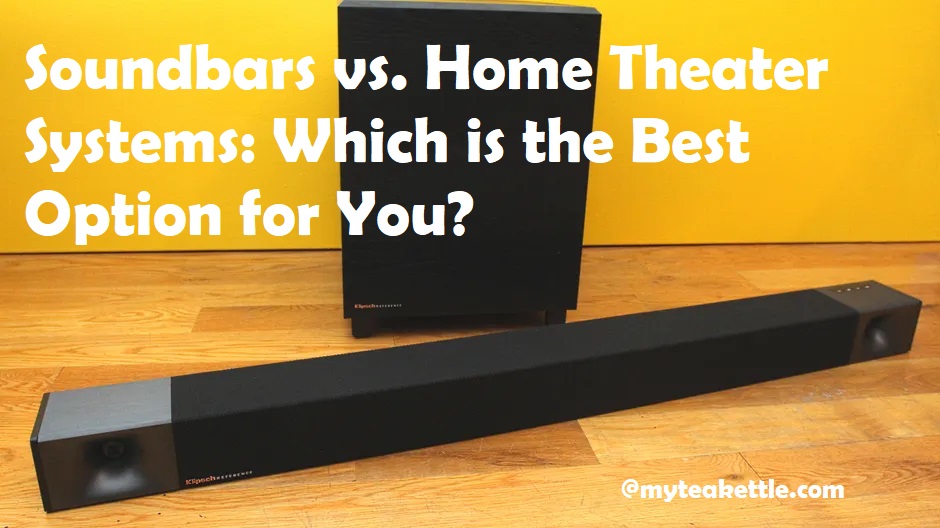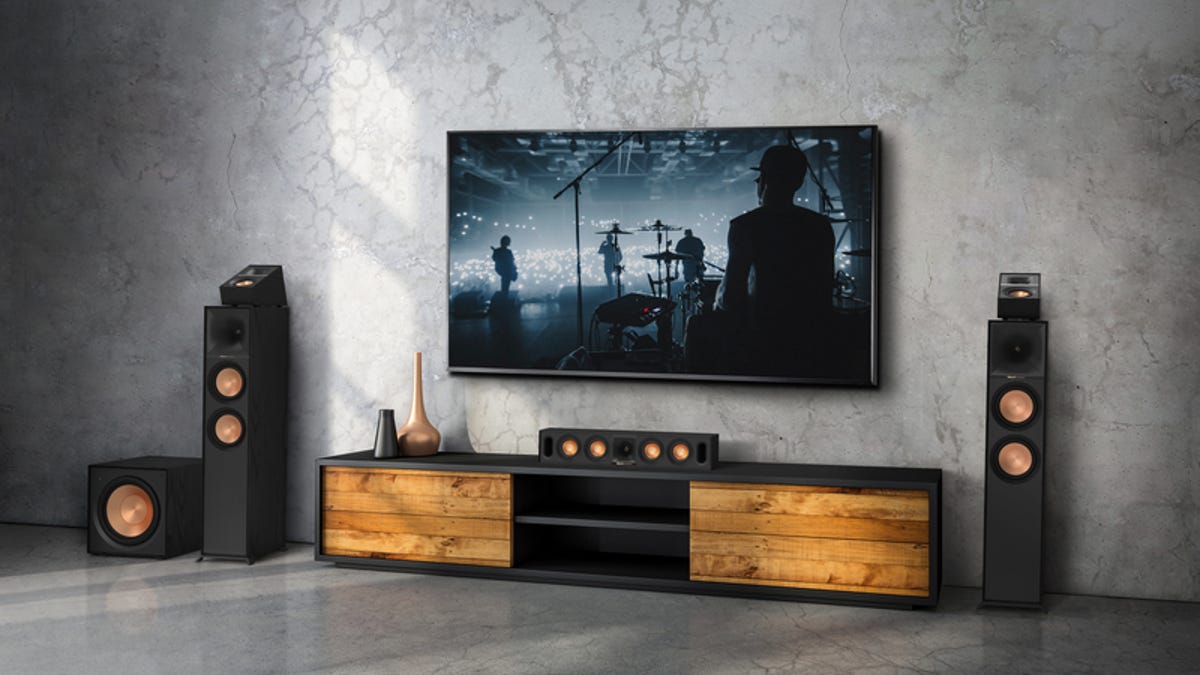Are you looking to improve the sound in your home theater? You need to decide between getting a soundbar or setting up a full-fledged home theater system. This article will help you find out the best choice for your needs. So, dive in to learn about the advantages and disadvantages of soundbars and home theaters!
If you want to enhance your entertainment experience with better sound, you’re probably considering a soundbar or home theater system. It’s not an easy decision. It depends largely on your audio goals, budget, and listening habits. To help you make the right choice, we’ve put together a guide that covers both systems – their benefits and drawbacks in detail.
This guide covers the basics of each system and will help you decide which is right for you. Read through it and before deciding, put equal weight on all three factors: audio goals, budget, and listening habits.
Learn everything you need to know about soundbars vs home theater systems here. This guide will discuss which system is best in terms of performance, installation requirements, convenience features like wireless streaming, setup time required for setup (or lack thereof), price range for each option–all things that should factor into your decision-making process. We’ll conclude with tips on how to get the most out of whichever system you choose. Let’s dive in!
Explanation of soundbars and home theater systems
Soundbars and home theater systems both offer incredible sound reproduction features. However, each type of system has its own advantages and drawbacks; so it’s important to understand the differences between these two options before making a decision.
Soundbar systems utilize compact designs in order to reproduce a powerful sound. A single unit contains several speakers that reproduce the sound in a specific area, meaning that the sound will not be heard in other parts of the room or house. This makes them ideal for smaller spaces: they can create an immersive experience without taking up too much space. Additionally, they are quite easy to install; once positioned and connected by wires, the soundbar is ready for use.
Home theater systems are typically composed of multiple speakers elements distributed around the room (or house). This allows for great audio fidelity for different types of programs: movies, music or TV shows can now be enjoyed with greater clarity and detail. Home theater systems also generally offer higher power levels than soundbar systems do: some offer up to 1,000 watts or more. Although installation is slightly more difficult than with soundbars due to wiring involved, home theater systems provide richer vocal textures and gives you greater control over your viewing experience –– you can adjust volume levels on each speaker elements according to your preference!
Importance of choosing the right audio system
Your audio system is an incredibly important part of your entertainment system and should be given considerable thought when selecting. Choosing the best audio system for your needs will result in improved sound quality, greater flexibility, and better home theater experience overall.
The two main types of systems are soundbars and home theater systems. Both have their advantages and disadvantages, which we’ll discuss below so you can make an informed decision about which audio system will work best for your lifestyle and budget.
Soundbars often have a simple setup process and come pre-programmed to provide excellent surround sound. They are relatively small in size compared to home theater systems, making them ideal for smaller rooms or apartments that don’t have room for separate speakers. Many also feature built-in subwoofers, meaning they provide rich bass without taking up too much space.
On the other hand, home theater systems tend to provide more options in terms of customizable settings like treble and bass levels as well as speaker placement which allows users to fine tune the audio output as desired. And because these larger setups can accommodate separate speakers placed around the space, they offer a truly immersive experience with believable surround sound that can completely immerse listeners in whatever content they’re enjoying. However, this does come at a higher cost due to needing multiple components versus simply plugging a soundbar into the TV’s HDMI port or placing it beneath or above the television itself.
Brief overview of the topic
If you are looking to maximize sound quality and take your entertainment experience to the next level, soundbars and home theater systems are both popular options that offer different levels of audio performance. Soundbars provide a straightforward, low-cost option for enhancing sound in a small-medium space with very little setup. Home theaters, on the other hand, come with a much more complex setup that requires careful planning and installation to successfully utilize them at their fullest potential. Both systems offer vastly different experiences, so it’s important to understand why you might opt for one over the other before making any decisions.
This guide will provide an overview of both types of audio systems so you can make an informed decision when it comes time to buy. We will discuss the advantages of each system as well as they key differences between them, various accessories that you may want to consider when building your own system, and finally some tips on how to shop around and get the best deal possible on your setup. By the end of this guide you should be well-versed enough in audio equipment that finding a solution which meets your needs should be much easier than when began this journey!
Home Theater Systems
Home theater systems are an ideal choice if you’re looking to design a full surround sound experience. These systems consist of a variety of specialized audio components, such as an AV receiver, speakers, and subwoofers that are designed to work together for maximum sound quality. Here is what you need to know about home theater systems:
AV Receiver: The AV receiver is the core of your home theater system. All other components connect to this device, which will then disperse the audio signals accordingly. A good AV receiver will allow for multiple inputs and can support 5 or 7 channel surround sound formats, such as Dolby Atmos or DTS:X.
Speakers: Home theater systems usually include several speakers – usually five or seven – depending on the system’s surround sound format. Speakers come in two varieties – bookshelf and floor-standing – and they can be placed around the room in optimal locations for a more immersive listening experience. Typically, front-firing speakers are around 60 inches apart (meant to be placed in front of and slightly above your viewing area), while side-firing speakers should be positioned further away from the sides of your TV (about 80 inches apart).
Subwoofer: Subwoofers offer low frequency notes in most multi-channel audio setups and they can even provide the “boom” you hear in explosions during movies or action sequences on TV shows. Most home theater subwoofers are powered by an integrated amplifier that provides even lower frequencies than standard speakers can produce on their own.
Aesthetics: When it comes to aesthetics, home theater systems have a lot of options available for customization. Speakers come in many different shapes and sizes, so depending on your space requirements you’ll find something that works with the layout of your room. With some models you may even have access to multiple colors and finishes so you can match them with any existing décor elements.
Definition and description of home theater systems
Home theater systems, also known as home cinema systems, are the most complete and immersive audio experience for your home. These systems typically use multiple components to provide an ultra-realistic surround sound effect for an all-encompassing audio experience. Home theater systems may include speakers, amplifiers (or receivers), subwoofers, and media sources such as DVD or Blu-Ray players.
In a traditional 5.1 or 7.1 system, each speaker is allocated its own sonic function within the mix that is delivered to each one in real time. This creates a more realistic soundscape with precise imaging that can fill large rooms with sound including an active subwoofer unit that adds bass reinforcement and deep sound pressure.
Alongside this, the circuit elements of a home theater system are built to deliver maximum quality and performance which ensures you get great results every time you watch a movie or play music in your home theater setup.
Features to consider when buying a home theater system
When shopping for a home theater system, there are a few important features to consider. While there is no “right” way to buy, these essential qualities are important when making an informed decision on which product is best for your home.
The number of components is the most obvious feature to consider when purchasing a home theater system. An entry-level “5.1” system will contain five speakers (left, center, and right as front channels, plus a Pair of Rear Surrounds) plus one powered subwoofer for bass management — this type of setup is ideal for most smaller rooms or casual viewing environments. Larger systems may have more speakers or higher-end electronics with advanced features like DTS-HD Master Audio decoding and support for 3D audio formats like Dolby Atmos or DTS:X.
It is also important to note that some systems come with an AV receiver (or amp) — this device connects all the other components, processes the audio and video signals, and routes them to different parts of the system (like speakers). A receiver might also include several additional inputs/outputs that allow you to easily integrate other components (such as gaming consoles or streaming media players). Knowing how many inputs and outputs you need can help narrow down your options!
If you don’t want all the wiring associated with a traditional multi-speaker home theater setup, then soundbars could be worth considering instead — they use one single unit instead of several discrete speakers,so they tend to be less obtrusive than traditional setups while offering significantly better audio quality than most TVs can provide on their own. However, if you’re looking for maximum performance from your entertainment experience then an AV receiver combined with high-quality separate speakers will always have an edge — it just depends on what your personal preferences dictate!
Sound quality
When it comes to sound quality, soundbars and home theater systems vary widely in terms of performance. Soundbars deliver an overall sound that is varied depending on the device’s size and shape, its audio specs (driver count, amplification type etc.), and the number of built-in audio codecs it supports.
Home theater systems, on the other hand, have traditionally been considered more capable of delivering more powerful theater-like sound quality due to their multiple speaker components configured for optimal efficiency — from subwoofers for deep drum kicks to satellites for subtle vocal nuances.
Soundbars are typically designed with smaller form factors where multiple speakers are packed close together and powered with a single amplifier system. This usually translates into a louder overall volume without sacrificing clarity or fidelity.
Home theater systems offer much more flexibility in speaker placement; their larger footprint allows you to experience realistic surround sound by placing the speakers at various points around the room for optimal coverage. The added benefit here is that home theater systems can deliver better directional sound effects and clearer dialogue to enhance your viewing experience.
Ultimately, both solutions provide maximum sound quality dependent upon their setup.
Size and design
When it comes to size and design, soundbars and home theater systems essentially offer two different approaches. Soundbars are far more practical when it comes to space as they take up very little space. This is great if you’re looking for something that can fit in limited areas, such as underneath a TV stand or on a shelf next to the TV. Soundbars also come in a variety of finishes and styles so they can be used to match the décor of your living room or help the TV stand out even more.
On the other hand, home theater systems are designed for ultimate performance, offering maximum flexibility in terms of speaker placement but taking up more space as well. The larger size allows for better sound quality but does require more room in your home or apartment. Generally, you’ll have speakers for left, center and right channels around the room with an additional subwoofer to provide deeper bass tones — all working together to provide immersive audio experiences no soundbar can match. Home theater systems will often come with accompanying speaker stands and brackets so you can get the best placement for maximum quality.
Connectivity options
When it comes to connecting a soundbar or home theater system to other devices, there is a wide range of options. For both types of audio systems, it is necessary to consider the types of inputs and outputs you will need for your setup.
Soundbars usually have fewer input/output ports than a home theater system, but most will still offer the necessary connection ports for your specific setup. These may include standard audio inputs (such as an RCA cable), digital optical input (used for connecting to HDTVs), HDMI 2.0 or 2.1 ports, Android TV support (for using streaming services such as Netflix or Amazon Prime Video), Bluetooth connectivity, and USB ports for playing music from flash drives and other similar devices.
For home theater systems, there are even more port offerings available that provide a lot more flexibility when setting up multiple speakers in different arrangements throughout your room. These can include a range of analog connection types such as RCA input/output ports and 3.5mm headphone jacks which allow for connecting different components and speaker systems to the receiver utilizing cables that split off into multiple setups throughout the room. It may also include digital interfaces such as HDMI ARC which allows the receiver to directly communicate with compatible displays over an ARC HDMI link and coaxial connectors for cable boxes and other similar components. Other features found on higher-end receivers can include wireless capabilities such as built-in WiFI or Bluetooth connectivity in addition to compatibility with Chromecast Audio devices or AirPlay 2 services from Apple devices.
Conclusion
At the end of the day, deciding between a soundbar system and a home theater system comes down to personal preference. While both offer users excellent audio quality and convenience, soundbars tend to be more affordable, while home theater systems offer surround sound.
For those looking for an easy one-time solution with no setup worries or budget constraints, a soundbar is likely best. Meanwhile, those looking for an immersive experience can invest in a home theater system for the ultimate audio upgrade.
If you’re still unsure about which route to take, don’t hesitate to talk to an expert in audio equipment or to do your own research into what product would work best for your specific needs and budget.
FAQ’s
Is home theater better than soundbar?
Home theater generally provides better sound quality and a more immersive experience than a soundbar.
Is it better to buy a soundbar or speakers?
It depends on your needs and preferences. Speakers can provide better sound quality, but a soundbar is more compact and easier to set up.
Can sound bar replace home theater?
No, a soundbar cannot fully replace a home theater system, as it usually lacks some of the components that make up a complete home theater setup.
Which type of home theater is best?
The best type of home theater system depends on your needs and budget. A 5.1 or 7.1 surround sound system with a receiver and multiple speakers is usually considered the best option.
Which soundbar has best sound quality?
The best soundbar for sound quality can vary depending on personal preference, but some popular options include the Sonos Arc, Bose Soundbar 700, and Samsung HW-Q950T.
Which home theatre has best sound quality?
The best home theater system for sound quality can also vary, but some top options include the Klipsch Reference Premiere 7.1, Sonos 5.1, and Yamaha YHT-4950U.
Which is better subwoofer or soundbar?
A subwoofer is a component of a sound system that is designed to produce bass frequencies, while a soundbar is a self-contained speaker system. They serve different purposes and can work together to provide a better sound experience.
Do soundbars have better sound quality?
Soundbars can provide good sound quality, but they typically do not match the sound quality of a full home theater system with multiple speakers and a subwoofer.
Why are people buying soundbars?
People buy soundbars because they offer an easy and compact way to improve their TV’s audio quality without having to set up a full home theater system.
What is the difference between sound system and home theatre?
A sound system can refer to any audio setup, while a home theater system specifically refers to a setup that is designed to provide a cinematic experience with surround sound, a large screen, and comfortable seating.
See Also-
- Best soundbar for projector
- Best soundbar for philips TV
- Best Soundbar For Outdoor Projector
- Best Soundbar For LG TV
- Best soundbar for hisense TV

